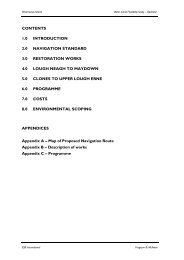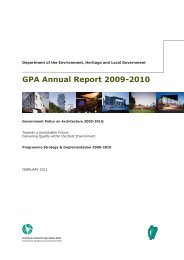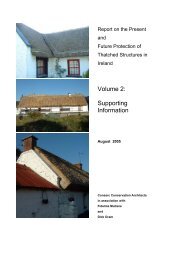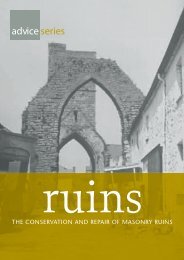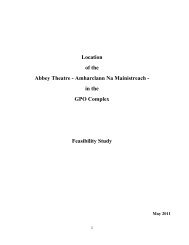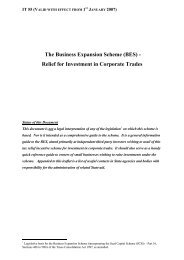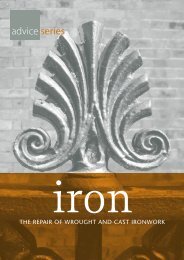A Guide to the Repair of Historic Roofs - Dublin City Council
A Guide to the Repair of Historic Roofs - Dublin City Council
A Guide to the Repair of Historic Roofs - Dublin City Council
You also want an ePaper? Increase the reach of your titles
YUMPU automatically turns print PDFs into web optimized ePapers that Google loves.
ROOFS A GUIDE TO THE REPAIR OF HISTORIC ROOFSPLANNING AND DEVELOPMENT ACTS 2000-2006Alternatively, or in addition, a his<strong>to</strong>ric building may be protected under <strong>the</strong>Planning and Development Acts by being included in <strong>the</strong> Record <strong>of</strong> ProtectedStructures (RPS) <strong>of</strong> a particular planning authority or by being located within anArchitectural Conservation Area (ACA). Where a building is a protected structure(or has been proposed for protection) or is located within an ACA, <strong>the</strong> usualexemptions from requirements for planning permission may not apply. In <strong>the</strong>case <strong>of</strong> a protected structure any works which would materially affect its characterwill require planning permission. Legal protection also extends <strong>to</strong> o<strong>the</strong>rstructures and features within <strong>the</strong> curtilage <strong>of</strong> a protected structure such as outbuildings,boundary walls, paving, railings and <strong>the</strong> like. In an ACA, any works <strong>to</strong><strong>the</strong> exterior <strong>of</strong> a building which would affect <strong>the</strong> character <strong>of</strong> <strong>the</strong> area alsorequire planning permission. Owners and occupiers <strong>of</strong> protected structures havea responsibility <strong>to</strong> maintain <strong>the</strong>ir buildings and not <strong>to</strong> damage <strong>the</strong>m or allow<strong>the</strong>m <strong>to</strong> fall in<strong>to</strong> decay through neglect.A notice is sent <strong>to</strong> every owner and occupier <strong>of</strong> a protected structure when <strong>the</strong>building first becomes protected. The Record <strong>of</strong> Protected Structures can be consultedin <strong>the</strong> development plan for <strong>the</strong> area. If a building is a protected structure,or if it is located in an ACA, <strong>the</strong> planning authority will be able <strong>to</strong> advise what thismeans for a particular property.The owners or occupiers <strong>of</strong> a protected structure are entitled <strong>to</strong> ask <strong>the</strong> planningauthority in writing <strong>to</strong> issue a declaration which will give guidance on identifyingworks that would, or would not, require planning permission. Maintenance andrepair works, if carried out in line with good conservation practice and <strong>the</strong> guidancecontained within this booklet, may not require planning permission. If anowner or occupier is in any doubt about particular proposed works, <strong>the</strong> architecturalconservation <strong>of</strong>ficer in <strong>the</strong> relevant local authority should be consulted.However, if <strong>the</strong> structure is also included in <strong>the</strong> RMP, notification under <strong>the</strong>National Monuments Acts is always required, notwithstanding an exemption fromplanning permission.For general advice on planning issues relating <strong>to</strong> architectural heritage, a publicationentitled Architectural Heritage Protection <strong>Guide</strong>lines for Planning Authorities(2004) is available from <strong>the</strong> Government Publications Sales Office or can bedownloaded from www.environ.ie.43





